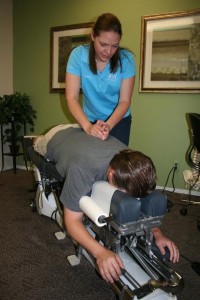What is Chiropractic?
Chiropractic was first developed in 1895. While still generally referred to as “alternative healthcare,” it is now recognized as a mainstream discipline, covered by many health insurance plans, including Medicare and Worker’s Compensation. Chiropractors in Nevada are regulated by Chiropractic Physicians’ Board of Nevada. Chiropractors in Nevada must hold the professional degree of Doctor of Chiropractic (D.C.) from an accredited chiropractic school, pass a national board exam, pass a state exam, and take 36 hours of continuing education every two years.
 The emphasis of chiropractic is the care of the human frame. In order for the body to function at an optimum level, Chiropractors emphasize that the frame (particularly the spinal column) must be symmetrical, flexible and properly aligned. Returning to and maintaining the frame in this ideal state helps improve posture and mobility, both of which are important to health.
The emphasis of chiropractic is the care of the human frame. In order for the body to function at an optimum level, Chiropractors emphasize that the frame (particularly the spinal column) must be symmetrical, flexible and properly aligned. Returning to and maintaining the frame in this ideal state helps improve posture and mobility, both of which are important to health.
Spinal alignment directly influences breathing, strength, coordination and energy expenditure. For example, more energy will need to be expended for doing everyday simple tasks (like walking and lifting) if you have a rotated spine, high hip or high shoulder. This results in feelings of fatigue and makes you more prone to developing back pain. It is not surprising that many elite athletes whose livelihoods profoundly rely upon peak body mechanics, utilize chiropractic care.
A spine which is poorly aligned has a greater susceptibility to degenerative changes and injury. Uneven distribution of body weight can and often does over time erode discs and joints. Additionally, movement with an abnormal alignment of the spine can degrade the function of proprioceptors, tiny nerves responsible for back muscle coordination and reflexes. Research studies have shown this as the common cause of lower back pain and degenerative joint disease.
First Visit
When a patient visits a Chiropractor for the first time, the Chiropractor will take a history of the patient’s chief complaint. A determination is then made as to whether other health factors are relevant to the condition(s). Such factor may include: previous trauma, heart disease, diabetes and lifestyle activities. An orthopedic and neurological evaluation is then performed. Depending on the situation, a skeletal X-ray may be required by the Chiropractor so that a more accurate determination of the alignment and condition of the affected vertebrae can be obtained; and to rule out the possibility of bone pathology or congenital malformations. After the preceding has been performed and evaluated, the Chiropractor will discuss with the patient his or her treatment recommendations.
Treatment
While the precise treatment varies depending on each patient’s needs, treatment generally consists of a series of “spinal adjustments,” which is a hand or instrument delivered force into the affected vertebra(e) to restore alignment and flexibility. Treatment also often includes supportive “modalities,” such as traction, myofascial release, ice/heat packs and electrical muscle stimulation. When the patient is no longer in an acute stage, home exercises and stretches are also generally prescribed.
Chiropractic treatment can benefit most people. There are conditions, however, that may limit or even prevent a person from being a chiropractic candidate. These include: patients with a history or risk factors for stroke; patients with severe osteoporosis; some cancer patients; and patients with surgical rods or surgically fused vertebrae.
